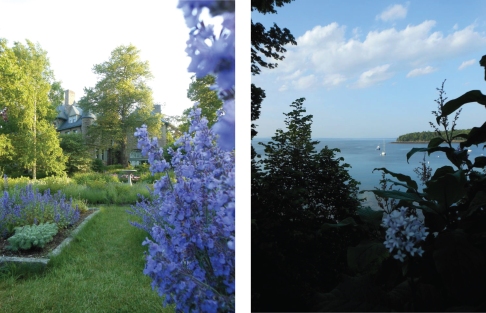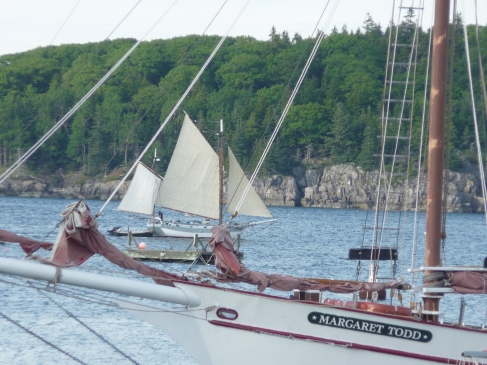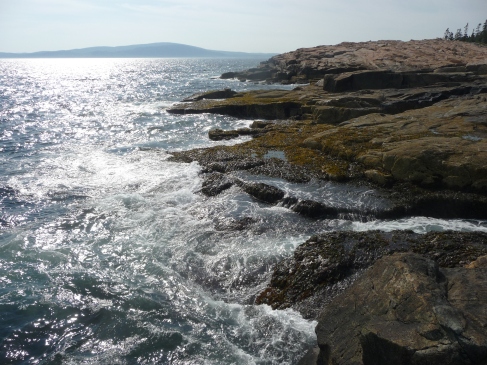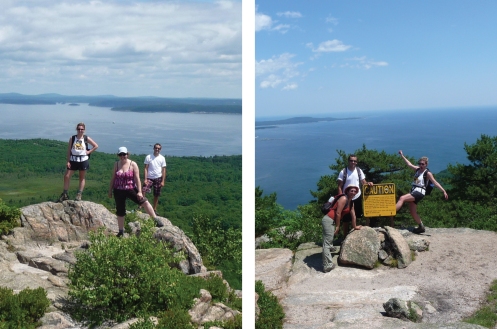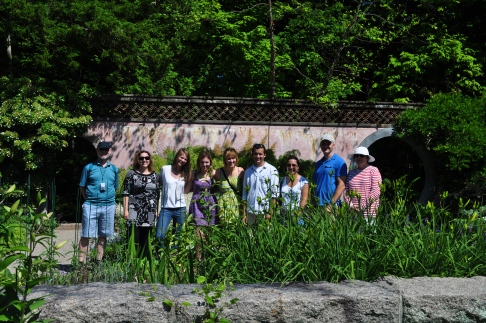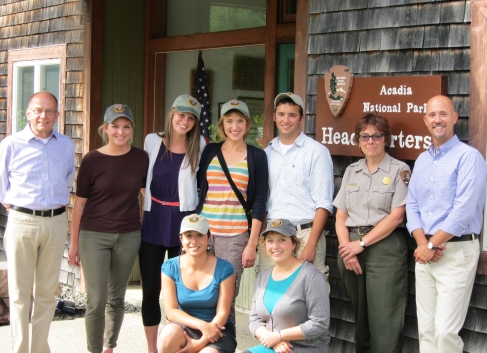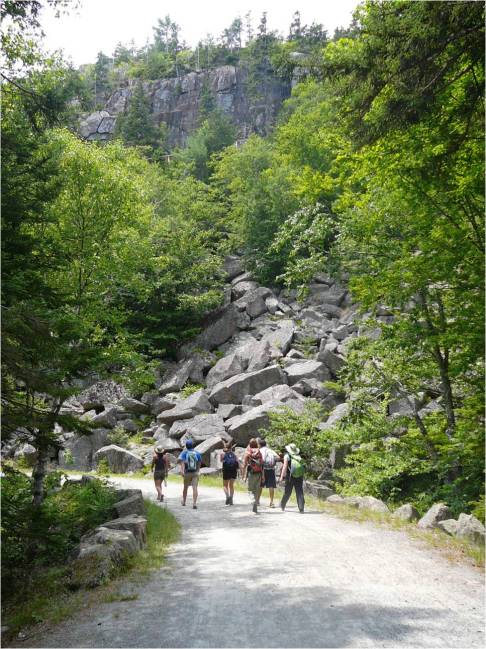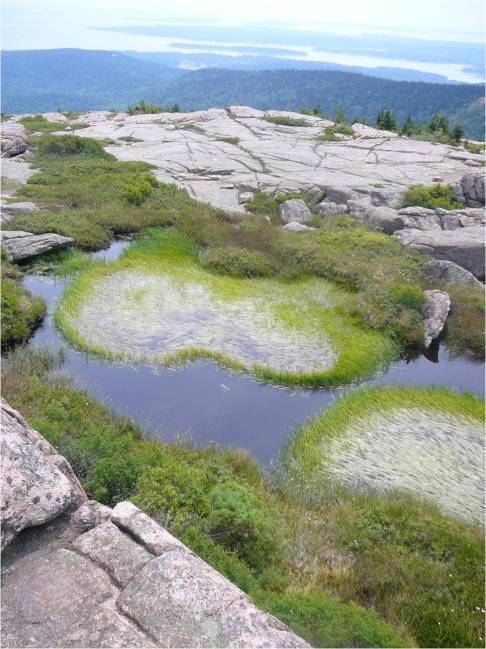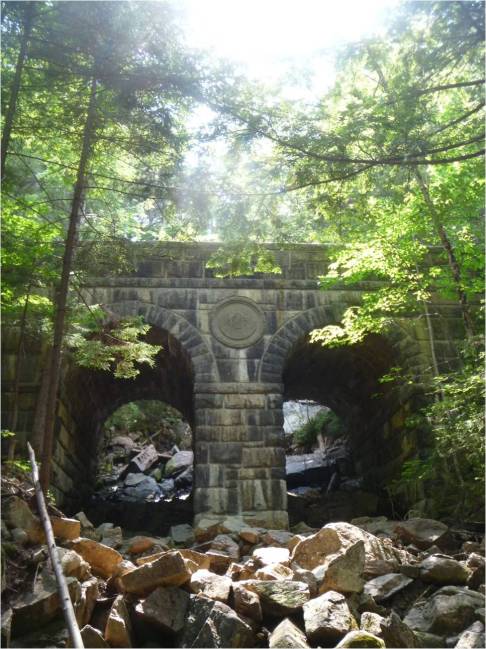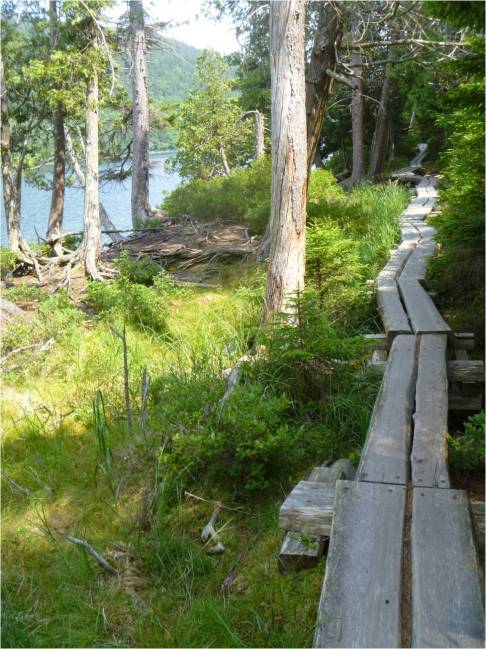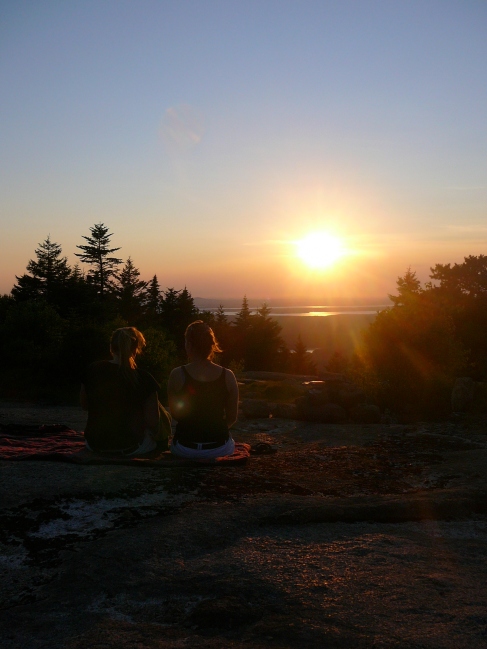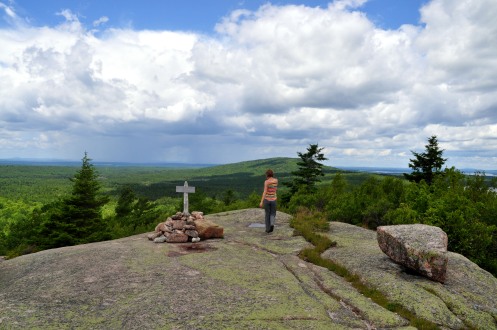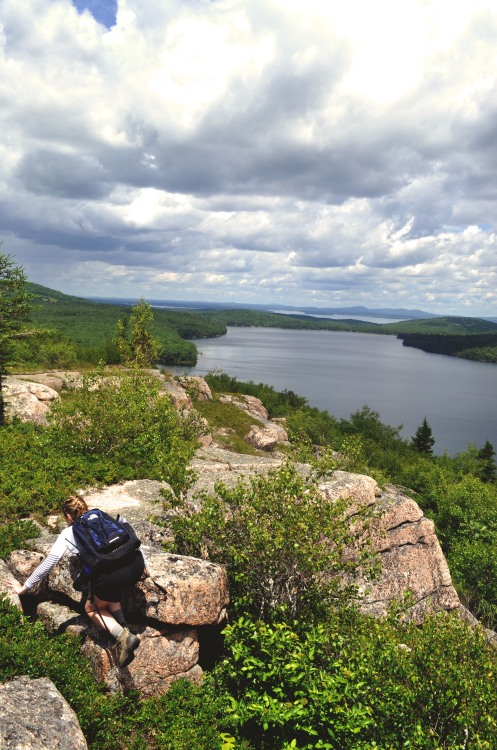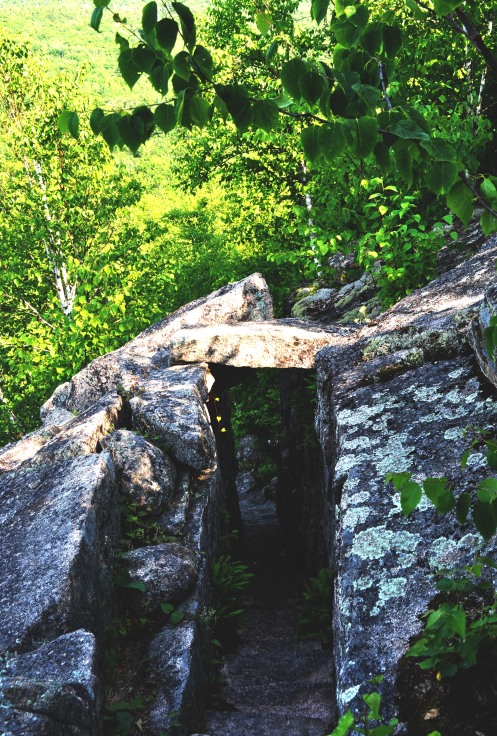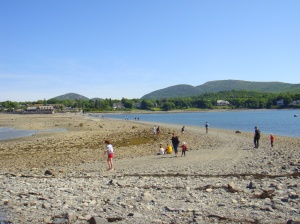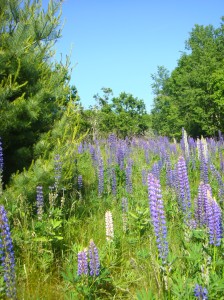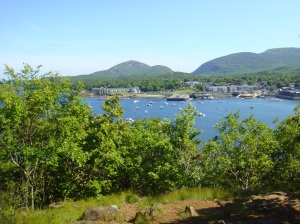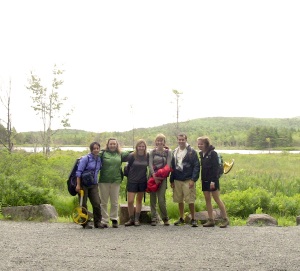July 20, 2012 (Edited on July 24, 2012)
Looking back at the six weeks that we have spent here in Acadia National Park and in Mount Desert Island (MDI), there is so much to write about. I remember our first day and how we thought it was too quiet and didn’t know how time would pass without a TV. Now, that all sounds so funny because during these six weeks it was so busy that we were hardly able to find time to eat or sleep.
The first week, we were all nervous and excited about this rare opportunity and new adventure of ours. After being overwhelmed by the fear of poison ivy, deer ticks, black flies and even red ants, additional stories of accidents that had occurred in the park didn’t make things any easier. However, at that time we did not know how things would start changing and we would come to love this place even with all its fears.
The first week’s lecture topics were mostly focused on getting to know the park, its development, the importance of the visitor experience and some insights on park management. These were the subjects provided from the perspective of the park staff. On the other hand, George Curry from SUNY-ESF and Bob Page from the Olmsted Center, who were also the organizers of this field school and the staff leads for that week would inform us about cultural landscape preservation, as well as the methodology on how to conduct our inventory for those landscape features.
Our field trips during that week included a trip to the Visitor Center and Thunder Hole, a walking tour in Bar Harbor with Robert Krieg from Coplon Associates and the first experience of the carriage roads both on foot and on bikes, where we almost ran over some eggs that a turtle was laying at that very moment.
How can I describe our famous first field inventory? I don’t know if I should talk more about our intensive data collection efforts or the long hours of data entry? Either way, we successfully completed our first cultural landscape inventory for the unforgettable carriage road segment “ACAD CR 6-4”.
By the time that weekend approached, we were all so exhausted that no one really cared about sightseeing. If we ever knew that we would get to love this island so much, I don’t think we would have wasted any day of it. It’s just that we were all so out of shape that we could hardly get up on our feet that weekend.
Still, we did not neglect to discover the College of Atlantic (CoA) and the Atlantic Oceanside, as well as making a quick trip to the Cadillac Mountain and having some delicious popovers at Jordan Pond House. That weekend we also attended the Interpwoods Training on campus to learn more about the 1947 fire and the early visitors of Acadia, the Wabanakis and the Rusticators.
View of the historic Turrets Building and the Atlantic Oceanside from the gardens of the College of Atlantic
Then the second week came, with the staff leads Margaret Bryant from SUNY-ESF, and Jeff Killion from the Olmsted Center. This was the week where we refined our methodology for the cultural landscape inventory of the carriage roads. We were getting more comfortable with our method and getting even more familiar with Acadia National Park. Meanwhile, we were finding the opportunity to learn about regional planning and the uses of GIS, as well as hearing about the work that was being done at Mount Desert Island (MDI) in this direction.
That weekend, though we were still feeling exhausted by the week’s work, we made a quick trip to Bar Island by walking over a sand bar that would only appear during low tide. We also went on our first boat trip to Frenchman Bay with Margaret Todd.
Looking at Margaret Todd from Bar Harbor just before it took us on a sailboat adventure
On our third week, Margie Brown from the Olmsted center joined us. While she and the hiking trails crew explained us about preserving and maintaining the trails, Louis Moran from the University of Maine told us about vista management with examples right from the field. Though we were unfortunate enough to have the batteries of our suburban die with no radios in hand, we were still able to make it to the first release of the Acadia National Park quarters, which we had been so excited about over the past weeks. Stephanie Clement, from the Friends of Acadia was another very interesting speaker in one of our sessions during that week. We really enjoyed hearing about the work that they had been doing with the park over the last 20 years. We ended our week with the really productive webinar session on scenic resource management with Robin Hoffman from SUNY-ESF.
That weekend was the first time we finally got a chance to go on a proper hike to the top of the Dorr Mountain. After that spectacular view at the summit, our main purpose in the following weeks was to hike as many trails as possible. Meanwhile, we continued discovering the beaches of MDI both on the ocean and the lake side.
View of Sand Beach while climbing the Beehive
Fourth week with Eliot Foulds from the Olmsted Center passed so quickly with the 4th of July celebrations cutting right through it. That week we learned about facility management and compliance from Keith Johnston and David Popelka. While we were completing the first trip of our carriage road inventory, it was all clear to how the data we collected would be used and appreciated.
That week’s highlights were the 4th of July parade, the hike to Bubble Rock and a short trip to the Schoodic Peninsula. Some of us also climbed the really dangerous Beehive and Precipice trails that weekend.
A view from the Schoodic Point
The successful completion of the Beehive and Precipice hikes
When the fifth week had approached we all had fallen deep in love with the island. On top of that, visiting the gardens of Abby Aldrich Rockefeller, which were designed and created with the assistance of Beatrix Farrand between 1926 and 1930, was a great addition. That week’s staff leads were John Auwaerter from SUNY-ESF and Betsy Igleheart from the Olmsted Center. With Richard Hawks, head of the landscape architecture department at SUNY-ESF, joining us on the trip, we had an unforgettable time. That same day we also got a chance to visit the Asticou Azalea and Thuya Gardens, as well as a quick trip to the Garland Farm, the last home of Beatrix Farrand.
The Abby Aldrich Rockefeller Garden (from left to right: Richard Hawks, Catherine Ponte, Charlotte Evanofski, Sara Bonacquist, Margaret Johnson, Benjamin Boisclair, Tutku Ak, John Auwaerter, Elizabeth Igleheart)
Meanwhile, during the lectures we learned more on historic preservation planning, National Register Documentation, Section 106 and Section 110, which all helped clarify how cultural landscape preservation worked at the state and federal levels. During the fifth week, we also completed our second trip to the carriage roads, where we recorded the natural features, as well as the experiential characteristics of the roads.
At the end of the week, one evening we went for the whale watching experience. Luckily we were able to see both the Humpback and the Fin whales, just before getting sea sick on our way back. That weekend we also had an amazing hiking trip through the Penobscot trail, which was a beautiful summary of what we had experienced in the park during the past few weeks.
When week six had finally arrived, there was a bit of sadness over us. We knew that we still had much more to do and enjoy in the island, but we also knew that it was time to go. That week, we started working on our final presentation with the supervision of George Curry and Bob Page, who were joining us for the second time. The evening prior to our presentation at the headquarters, after briefly celebrating George’s birthday at the Cottage House, we luckily got a chance to see Ann Roberts Rockefeller, granddaughter of John D. Rockefeller Jr., who had come to talk about her most recently published book on the carriage roads. At the end, it seemed like everything was fitting like the pieces of a puzzle.
The day of our final presentation, which would also be the last day that “the Acadia Six” would all be together in MDI, went really well. There were around 50 people that had come to listen to our presentation and therefore we were quite nervous. When it all ended, there was both relief from completing our work and sadness for having to leave this beautiful island!
It was particularly hard to say goodbye to Rebecca Cole-Will from the Cultural Resource Division of Acadia National Park, who had helped us with every step of the field school during our six weeks of stay. Where she could not assist, there was David Manski from the Natural Resource Division, which we could have never gotten a chance to see the impressive whales if it wasn’t for him.
After our final presentation at the Acadia National Park Headquarters with our volunteer hats (back row, from left to right: George Curry, Sara Bonacquist, Charlotte Evanofski, Margaret Johnson, Benjamin Boisclair, Rebecca Cole-Will, Bob Page; front row, from left to right: Tutku Ak, Catherine Ponte)
Finally, I feel the need to mention about Heather Albert-Knopp and Ellyn Getz, the coordinators of the summer programs at the College of Atlantic, who both were so helpful during our stay at the Cottage House. Also, I can’t seem to leave out some of the new friends that we made; the red squirrel that greeted us every now and then, the funny hen and the guinea pig of the CoA, as well as our friendly mouse who we would dine with almost every night. Luckily and surprisingly, there was not a single incident of a tick bite at the end of the six weeks of the field school.
George Curry and the Acadia Six at the Cottage House (from left to right: Tutku Ak, Margaret Johnson, Sara Bonacquist, Benjamin Boisclair, Charlotte Evanofski, Catherine Ponte, George Curry)
More stories and pictures about our summer field school can be found at http://www.facebook.com/AcadiaNationalParkSummerFieldSchool12
July 20, 2012 (Edited on July 24, 2012)
At the end of the fifth week we had an amazing hiking trip on the Penobscot trail, which was a beautiful summary of what we had experienced in the park during the past few weeks. The trip started with an easy walk along the carriage roads, followed with a strenuous climb up to the summit of the Penobscot Mountain. Just as we thought that that was the end, there appeared to be something even better. Right across the valley we could see the summit of Sargent Mountain. And there it was, a wonderful surprise waiting for us! We could see a small pond on top of the mountain. After a short hike we reached the pond, where some of us jumped in to the water with swimsuits and others with clothes on. After a refreshing swim, we started climbing down the mountain along a dried up waterway, which also had an amazing view of a historical bridge running over it. The final stretch of walk was along the shores of Jordan Pond, occasionally on wooden boardwalks. Our 3 to 4 hour long hike finally ended with the smell of popovers at the Jordan Pond House.
I don’t think I need to emphasize what a beautiful experience that all was and that there could not have been anything better describing our experience on the island during the last five weeks that we had been there.
Walking along a carriage road at the Amphitheater Loop
From the summit of the Penobscot Mountain
A short swim at Sargent Mountain Pond
The Deer Brook Bridge on the way down
The final walk along Jordan Pond
The Acadia 6 team has been hard at work for over a month now inventorying the carriage roads and learning about national parks. This week we celebrated the completion of the data gathering phase of our project. Learning about the carriage roads has been an amazing process. We all have come to appreciate the stonework involved in their creation, the often beautiful drainage systems designed for them, and the dedication of so many creative people to keeping these roads as enjoyable park spaces. While gathering data can at times be a tedious process, the lovely and welcoming setting of Acadia National Park has kept us inspired.
In addition to all the work we have been doing in the field and at home entering data, we had a chance this week to learn about how cultural resources such as the carriage roads are evaluated and protected. John Auwaerter from the SUNY ESF Center for Cultural Landscape Preservation came up to Acadia to share his knowledge on historic preservation planning and cultural landscape reports. He explained National Park Service methods for identifying and evaluating cultural landscapes. John also reviewed with us the basics of historic preservation law and how this applies to landscapes within the National Park Service.
Acadia National Park Cultural Resource Program Manager, Becky Cole-Will, also kindly shared some of the basics of how the National Park Service makes sure that their historically significant cultural resources are accounted for and properly protected. She reviewed how under section 110 of the National Historic Preservation Act all federal agencies need to inventory and evaluate their resources for historic significance. Our work documenting the carriage roads will assist the National Park Service in this effort.
We also enjoyed a visit this week from National Register Coordinator Betsy Igleheart of the NPS Olmsted Center for Landscape Preservation. Betsy gave us an overview of the National Register Program and explained how sites are selected to be listed for protection. A specialist in landscape history and the work of Landscape Architect Beatrix Farrand, Betsy enthusiastically oriented us on a tour of some of Farrand’s surviving MDI gardens. Farrand, one of the few female landscape architects working during the first decades of the twentieth century, created incredible spaces alive with mood and detail. For more information about Beatrix Farrand and our visit to the gardens please see:
https://acadianationalparkfieldschool.wordpress.com/2012/07/16/the-gardens-of-mdi-beatrix-farrand/.
We complete this 5th week with a better understanding of the basics of federal historic preservation law, how cultural resources are managed in a national park, and how landscapes function as cultural resources. It’s hard to believe that we’re on to our final week in Acadia and the completion of our program!
It’s been really busy here the last couple of days as we students try and finish up not only all of our data collection and summary pieces, but all of our outings and must-see experiences.
One of those things thats been on our to-do lists since we first got here has been ‘See-Sunrise-from-Cadillac-Mtn’, as its said to be the first peak that sees daybreak on the Eastern states. Being the college students that we are, when we found out sunrise is around 4 am, we let that item fall farther and farther down the list of ‘To-do’s.’ One impromptu evening adventure to the summit and we found out Sunset (~8pm) on Cadillac Mtn is almost just as delightful as sunrise. And, you don’t have to fight for a spot to sit!
Week 4 of the Field School brought us Elliot Foulds, historical landscape architect and Senior Project Manager/Preservation Planner for the NPS Olmsted Center. Elliot spoke to us about his experience conducting the Cultural Landscape Inventory for the motor roads and what he does on a daily basis as a historical landscape architect. We also had the pleasure of talking to Acadia National Park staff Keith Johnston, Chief of Maintenance, and David Popelka, Facilities Manager, where we learned about the challenges of prioritizing the hundreds of on-going projects the park deals with, from clean drinking water to park infrastructure to visitor experience and safety. The database that organizes this information, the FMSS (Facilities Management Software System), documents every resource in the park so they know what they have, where the have it, and what condition it’s in. Not only is the FMSS important in assessing condition, but also in assigning resources different levels of priority, and in receiving funding from the Department of the Interior. From the FMSS, Keith and David can build the Park Assessment Management Plan (PAMP), which targets funding for various projects. Without conditions documented in the FMSS, Keith and David can’t ask for any funding, and the money will go to other projects in other parks. As the information they currently have on the carriage roads is lacking, it was a nice reminder that the work we are doing will be of great value to the park!
We also took a visit back to Coplon Associates, where we got a better perspective on the work load of a small-scale practice. Though their staff is small, their work is thoughtful and elegant, with projects ranging from small scale private residences to the master plan for Acadia’s newly acquired Schoodic Peninsula. Sam Coplon also shared with us some thoughts on starting up his own firm as well as the day-to-day matters he faces as a professional member of a small community, as a resident of a small community, and as a designer in a small community.
It was a short week with the 4th of July on Wednesday, so we took the opportunity to explore some of the island’s holiday traditions! Starting with the Parade, moving on to the Seafood Festival, and ending the day with the annual Bar Harbor fireworks!
This past weekend I was fortunate enough to see Mountain Desert Island from a whole new perspective: 2,500 feet in the air. The Island we all think is big as we drive the curvy roads is actually fairly small in size. Acadia’s mountains, valleys and sand beaches below were transformed into a unified piece along the coast of the Atlantic. Looking down on the Park Headquarters, The Cottage (home), Bar Harbor and even some Carriage Roads, it was clear the island was developed with reason and each destination has it’s own spot nestled into the landscape. The flight proved to be a must-do when in Acadia National Park on Mount Desert Island, ME.
Enjoy!!
-Ben
Over the last few weeks, the Acadia 6 have all had a chance to explore the beauty of Bar Island. The island is accessible by a large sand bar that connects it to Mount Desert Island at low tide. Lucky for us, the sand bar is just a short walk away from where we are staying at the College of the Atlantic. The sand bar is a popular destination for both locals and tourists. In addition to great views, the sand bar is covered in tide pools containing sea snails, barnacles, sea weeds, and small crabs.
Unlike the sand bar, Bar Island is part of Acadia National Park. Once on Bar Island, there is a park trail up to a scenic vista. The trail circles upward through a forest and opens into a clearing of lavender and pink lupine flowers.
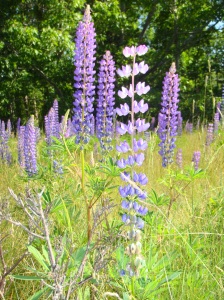
While pretty to look at, the aggressive growth habit of lupine plants can interfere with park ecosystems
After the clearing, it is only a short walk up to the island summit marked by a large cairn. There you can see beautiful views of MDI and the surrounding bay.
Our third week working in Acadia National Park introduced us to Margie Brown, senor project manager from the NPS Olmsted Center for Landscape Preservation. Margie spoke to us about her work preparing the 2006 cultural landscape report for Mount Desert Island’s historic hiking trail system. She described in enthusiastic detail about Acadia’s trail systems, where many trails are over a century old, and the importance of park trails as cultural resources. Margie’s expertise in historic trails helped us fit our project within the larger context of ongoing research projects to inventory and understand culturally significant park trails. To help deepen our understanding, Margie also introduced us to Acadia National Park trails foreman Gary Stellpflug and trail worker supervisor Chris Barter. Gary and Chris vividly explained the artistry that went into the original production of these trails and the creative strategies they have employed to maintain these trails for present use. We found it interesting to see similarities of approach in the technical creation and maintenance techniques of both the hiking trials and the carriage roads.
This week we also learned about the work of managing scenic and natural resources within parks. University of Maine professor, Louis Moran, took us on a tour of the park vistas that he has worked with forestry students to maintain. Professor Moran described the intricate tree removal and pruning techniques necessary to keep a view open while not creating a noticeable ecological and visual disturbance. Later in the week, SUNY ESF professor, Robin Hoffman, helped us explore this topic further through an informative webinar on the history of scenic management in parks. Through reading assignments and her lecture, Professor Hoffman taught us about the gradual embrace of a forest’s scenic beauty as a resource in its own right and the challenges of trying to place quantitative value on the largely qualitative and experiential value of a beautiful view. We also discussed current scenic impacts on Adirondack State Park in relation to what we have learned about the protective measures in place for Acadia National Park.
Finally we had the pleasure of meeting Stephanie Clement from the Friends of Acadia who shared with us the history of this non-profit group and explained their ongoing role supporting Acadia National Park. We were impressed by the accomplishments of this very positive and effective public-private partnership, especially seeing the before and after pictures from their work restoring the carriage roads. Their hard work, strong internal organization, and willingness to find win-win solutions to park challenges clearly make the Friends of Acadia stand out as a model partner organization.

